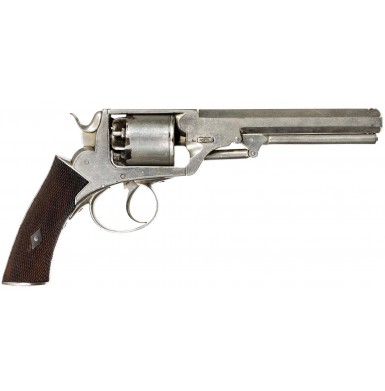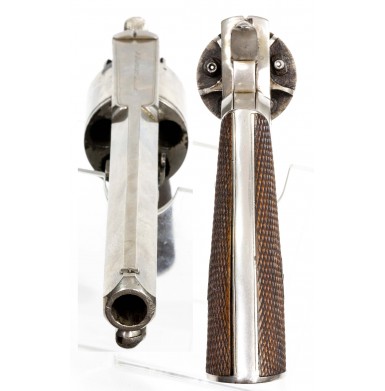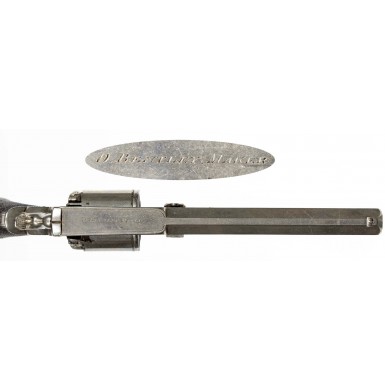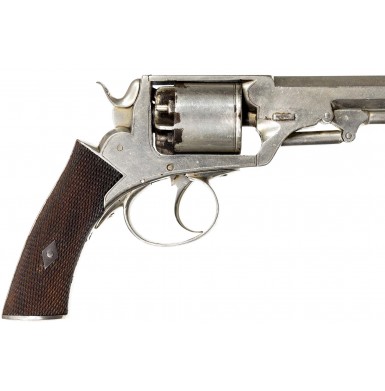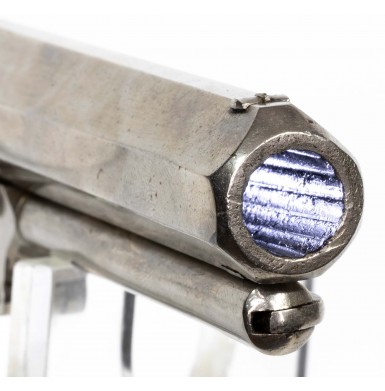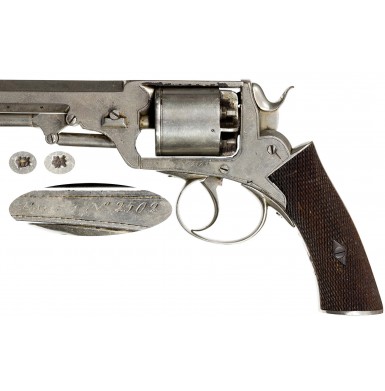Inscribed Webley Wedge Frame Revolver to Lt. Horace Chevallier of the 1st NY Light Marine Artillery
- Product Code: FHG-JM134-SOLD
- Availability: Out Of Stock
-
$1.00
This is a FINE example of the English Webley Wedge Frame double-action percussion revolver, as produced from the late-1850s through the mid-1860s. These guns provided less expensive alternatives to the Adams and Tranter patent revolvers of the day. The primary cost savings was in the use of a two-piece frame and barrel design, similar to Colt revolvers, with the two parts held together via a “wedge”. Adams and Tranter revolvers utilized a one-piece frame and barrel assembly that was forged from a single piece of iron and were much stronger and less prone to breakage and wear with age. The one-piece design could not “shoot loose” with repeated use, as wedge secured two-piece revolvers could. The “wedge” frame design is attributed to Birmingham gun maker Philip Webley, although Webley himself seemed to have manufactured very few of the guns. The simplified double-action lock mechanism typically encountered in these revolvers is usually of the Joseph Bentley design, and these guns are often referred to as Webley-Bentley revolvers, even though they were produced by many Birmingham gun makers and are often unmarked.
This Webley wedge frame is very well made and has an action more akin to that of the Beaumont-Adams than the typical Bentley style double-action only mechanism. The gun has a top strap over the cylinder to reinforce the frame, a feature missing from most Webley-Bentley guns. The gun is typical of larger bore English double-action revolvers in that it features a five-shot cylinder. As is typical of Webley style guns, this one has numbered cylinder chambers, as well as the expected Birmingham commercial proofs between each chamber. The revolver has a 6 1/8” long barrel octagon barrel and is chambered in the popular English 54-bore, which is about .442 caliber. As previously noted, the action is more akin to the Beaumont-Adams lockwork of the era, and the gun is a “conventional” double action revolver. It operates as a standard double action by pulling the trigger, which rotates the cylinder, cocks the hammer, and releases it; all with one long, heavy trigger pull. The action also allows for more precise shooting. By thumb cocking the hammer and firing the gun in single action mode, a lighter trigger pull is available. In typical English revolver style, the cylinder only “locks up” when the trigger is pulled completely back (in double action mode) or when the hammer is locked in the fully cocked position (single action mode). This eliminates the need for a spring actuated cylinder stop in the bottom of the frame, a feature typical of American guns of the era like those of Colt and Remington. While some of the Webley “wedge” style guns are described as utilizing a “Colt style”, under barrel loading lever, these were really Bentley Patent loading levers. They used a hinged, pivoting ramrod and plunger combination like the Colt but were retained in the up position by a pin that projected from the bottom of the barrel and entered the lever where it was secured by a spring-loaded latch. Later production Wedge Frame revolvers used a Kerr Patent style lever as found on many Adams revolvers. This revolver uses the Bentley patent “Colt style” lever, which is typical of guns in this serial number range. Top strap markings on this pattern of revolver vary greatly. Extant examples of this style of Webley Wedge Frame revolver are known with no markings on the top strap, with simply the word LONDON, and with the names P WEBLEY & SON, D. BENTLEY PATENT and J ADAMS, which is found both with and without the additional word “LONDON”. A handful of examples of similar English double action revolvers are known with Antebellum Southern retailer marks, usually from New Orleans. New Orleans seems to have been a major source for imported English revolvers prior to the Civil War. Extant examples include guns retailer marked by Thomas Bailey of New Orleans. At least three variations of Bailey’s mark are known on Wedge Frame revolvers.
This example is engraved D. BENTLEY MAKER on the topstrap. This is the mark English gunmaker David Bentley. David, not to be confused with Joseph Bentley who held the patents for the Bentley revolver action and loading lever, worked in Birmingham from 1845-1883. He was listed in period directories as a “Gun & Pistol Maker” and as of 1861 he was also noted to be a “Revolving Pistol Maker” as well as an “Implements Maker”. Initially Bentley worked on New Church Street from 1845-1849, then moving to 55 Hockley Street. He was located at 5 Lower Loveday Street from 1855-1861 and then 61 & 62 Loveday Street from 1860-1863. He relocated to 44 Shadwell Street in 1863 where he remained through 1871, when he moved to the “Tower Works” at 45 Tower Road, Aston. Bentley would remain at this location through the end of his career.
The lower left side of the frame of this revolver is engraved simply PATENT No 2502, below the cylinder. The only other markings are the previously noted Birmingham commercial proofs and chamber numbers on the cylinder and a pair of Birmingham commercial proof on the lower left angled flat of the barrel.
These reliable and reasonably priced double-action revolvers were popular export items and were available for sale around the world. Confederate purchasing agents acquired these revolvers, as they were much less expensive than the competing Adams, Tranter and Kerr pattern handguns. The Pratt Roll, which is an inventory list of revolvers that details the 15 handguns in the possession of Company H of the 18th Virginia Cavalry in July of 1864 lists 3 Webley and/or Bentley revolvers, as well as 4 guns of “unknown” pattern. The balance of the revolvers on the list are 7 Kerr’s patent revolvers & 2 Tranter’s patent pistols. The Bentley numbers on the list are 3111 and 3221, while the Webley revolver is number 5054. This indicates that even in this small sample of CS used revolvers, 20% were of the Webley and/or Bentley patterns. As the average company grade officer would probably not be familiar with the names and patterns of English revolver manufactures, other than possibly Adams and Tranter, I have a feeling that the guns were identified by the maker or retailer name on the topstrap or frames of the revolvers. This suggests that #3111 and #3221 were likely “D Bentley”marked Wedge Frame revolvers, and #5054 was probably a P. Webley marked Wedge Frame. The “unknown” revolver with serial number #3563 was almost certainly a wedge frame revolver as well, but with no retailer mark on the top strap. The “unknown” revolvers with serial numbers 33,609 and 36,604 were almost certainly Adams’ patent Model 1854 revolves, also with blank top straps. Based upon the very small sampling of likely “Wedge Frame” revolvers on the Pratt List, this revolver falls about 500 numbers below the “Bentley” marked guns in the low 3,XXX range. While there are no direct Confederate Central Government contracts known for this pattern of revolver, some Confederate correspondence exists that suggest the more reasonably priced double action revolvers (in both 80 bore and 54 bore) were purchased primarily by speculators for importation to the Confederacy. It appears that most of these guns were imported through Mexican or Texas ports and many saw use in the Western Theater as well as the Trans-Mississippi Theater. It is believed that the revolvers delivered by Nelson Clements, who had a contract to deliver 5,000 revolvers to the Houston Quartermaster, were of the wedge frame pattern. A handful of guns that appear to have been part of his deliveries are known, and they are in the low 2,XXX serial number range, and obviously numbers above and below that point would be potential Clements contract arms due to the size of the order. Additionally, examples of Webley Wedge Frame double action revolvers exist with Confederate provenance. These include several well-documented Webley Wedge Frame revolvers in museum collections. The gun of Colonel John Smith of the 20th Alabama Infantry (ex-Bond collection) is one such example, as is one reported to be engraved to General William Mahone. Both pistols are in the National Civil War Museum (formerly the Museum of the Confederacy) collection, to the best of my knowledge. Another Webley Wedge Frame revolver, formerly in the famous Richard Steuart Collection, resides at the Virginia Historical Society in Richmond. The Webley Wedge Frame revolver #5553 is identified to Captain George Russell, the quartermaster of the 47th TN Infantry Regiment. It appears quite possible that some of the Webley Wedge Frame revolvers may have entered the south through the port of Wilmington, NC, more than likely as speculative purchases.
This particular gun is probably one of those Wilmington imported, southern-purchased guns that bears an interesting inscription on the butt. The inscription reads in seven lines, in a lovely flowing period hand:
Presented / to / Lieut. / Horace / B. / Chevallier / March 21st / 1862
Horace B. Chevallier was 24 years old when he enlisted in the 1st New York Marine Light Artillery on January 6, 1862. On 12 March 1862 he was mustered as a 2nd Lieutenant in Company F of that regiment and was officially commissioned on 21 May 21 1862 with the commission to date from January 7, 1862 to establish his seniority of rank over other 2ndlieutenants in the regiment. The 1st NY Marine Light Artillery was established on 12 November 1861 and mustering continued through August of 1862. The regiment was somewhat unique in that the members were recruited from two states, with many of the men coming from Chicago, IL as well as from New York. The regiment had been raised to serve on the gunboats of the US Navy that were working in the coastal regions of the south and on the rivers as the “brown water navy”. A lack of trained seamen to serve on these boats made it necessary to supplement the crews with large numbers of landsmen who would be trained to work the guns of the ships. As the regiment was organized, it was sent initially to Annapolis, MD where it was likely trained in basic boat handling skills and as well as in artillery. The regiment was sent into service in divisions as it was trained, with Companies A through G being sent to serve in North Carolina in support of Burnside’s operations against the Confederate strongholds there in March of 1862. The remaining companies followed in August of that year. The first engagement that the 1st NY Marine Light Artillery was in involved in was on 14 March 1862 in New Berne, NC where one man was wounded. Over the next few months, the regiment was engaged at a number of sites in North Carolina including Tranter’s Creek (6/6/62), Little Washington (9/6/62), Washington (9/6/62), New Berne (9/26/62) and Kinston (12/1/62). They also saw combat at Hamilton, VA on 5 November 1862. Despite being mustered as a three-year regiment, it was disbanded in March of 1863. During the course of its service, the regiment lost one officer and fourteen men killed in action, two men mortally wounded and one officer and seventy-two men who died of disease for a total of 90 casualties. Chevallier only served for about a year and was discharged on 22 November 1862, about four months before the rest of the regiment. While the regiment served well for the most part during Burnside’s 1862 expedition to North Carolina, their service was far from unblemished. Many of the men of the regiment were led to believe that they were to be paid $18 per month as were US Navy seamen, instead of the standard $13 per month for a private in the Army. By the fall of 1862 many of the regiment were quite disgruntled due to the failure of the government to make up the difference in pay, as well as the lack of payment of promised enlistment bonuses. It was further found that due to fraud and mismanagement within the regiment that many of the Chicago men were never paid or even issued uniforms, resulting in what the Chicago papers called the “Marine Artillery Swindle”. Some 300 men mutinied and were subsequently arrested and jailed. This resulted in the premature disbanding of the regiment.
The presentation on the butt of the revolver most likely commemorates Chevallier’s commissioning as a 2nd Lieutenant in the regiment. However, I believe the presentation was engraved on a Confederate revolver that was captured during the Battle of New Berne on 14 March 1862. This was the first engagement in which the regiment was involved. A handful of inscribed, captured Confederate arms are known from the early battles of Burnside’s North Carolina Expedition. These include a captured Confederate-used shotgun that I previously owned and which was featured in our book Confederate & Southern Agent Marked Shotguns. This gun was captured during the battle of Roanoke in February of 1862 and engraved with a presentation to J.W. Page, a US military surgeon. I mention this because the style of engraving on the butt of this revolver is very similar to that found on the Page inscribed shotgun, suggesting that the same jeweler in the coastal North Carolina area around New Berne may well have engraved both guns. Since it is unlikely that one of these English revolvers was already owned by Chevallier or ordered by his men to present to him, I feel that the gun was more likely a captured piece. Additionally, revolvers of this pattern were known in Confederate service, as well as Webley Wedge Frame revolvers with serial numbers very close to this gun. These include the J ADAMS marked wedge frame guns #2444 and #2466, as well as the D BENTLEY marked guns on the Pratt List that are #3111 and #3221.
This double action Webley Wedge Frame is a classic “export” revolver and is unmarked externally except for previously mentioned D BENTLEY MAKER mark engraved on the topstrap, the chamber numbers on the cylinder chambers, Birmingham proofs on the barrel and cylinder, and PATENT No 2502 engraved on the left side of the frame.
The gun remains in about FINE and retains about 90%+ of its later applied period nickel finish. The finish is most certainly period with the slightly milky patina and yellowish tinge typical of mid-19th century nickel plating, but the finish is not original to the revolver. More than likely the gun was originally the standard blue finish found on guns of this pattern and in my opinion Chevallier probably had the gun plated in New York after leaving the military. This would have been a fine way to preserve a memento of his military service and the North Carolina Expedition. The revolver shows some finish loss from flaking and minor handling wear. The areas where the nickel has flaked have developed a thickly oxidized brown patina with some minor surface roughness. The plating has made some of the markings and engraving a little weak, by filling in the marks. The chamber numbers were most affected by this process and these numbers are quite hard to see. Thankfully the balance of the markings remain relatively clear and legible. The revolver remains functional in double action mode but does have a couple of mechanical issues. The hammer will not hold at full cock, so the revolver cannot be used in single action mode. Additionally, the trigger return spring appears to be broken, so the trigger must be manually reset after it is pulled. The gun does time, index and lock up exactly as it should in double action, but as noted the trigger must then be manually reset and the gun will not operate in single action mode. The bore of the revolver rates about VERY GOOD. It is partly bright and retains very crisp rifling that consists of sixteen lands and grooves, with the grooves approximately half the width of the lands. There is a moderate amount of scattered oxidation in the bore as well as some lightly scattered pitting. The revolver retains all five of its original percussion cones (nipples), which show some erosion from firing and use, but remain very crisp and useable today. The fact that the cones are nickel plated is further proof that the gun is refinished. The original dovetail mounted front sight is in place on the top of the barrel, near the muzzle as well. The blade is worn and short but is original. The two-piece checkered wood grips are in about NEAR FINE condition as well. They show some use and wear, with some flattening and smoothing of the checkering from carry and handling. The grips are in solid condition, with no breaks, cracks or repairs noted. The grips show wear commensurate with the flashing erosion found on the rear of the cylinder in the cone (nipple) recesses and match the revolver perfectly.
Overall, this is a very attractive example of a rather scarce English percussion revolver that is inscribed to a Union Lieutenant that served in an interesting regiment during Burnside’s North Carolina Expedition. Even though the Confederacy probably imported several thousand of these pistols, they appear for sale only rarely, and when they do often show hard use and mediocre condition at best. These guns did not have the name recognition or “cache” of similar pistols by Adams and Tranter and were probably more likely to have been used in the post war era than saved as mementos of the “late unpleasantness”. These sturdy working man’s revolvers certainly saw use during the war, and this one is right in the range of the known Confederate purchases and just below the serial number range of some of the best documented Confederate used Webley Wedge Frame revolvers, those on the Pratt Roll. The period inscription to Lt. Chevallier makes the gun even more intriguing. It would be a worthy research project to see if any additional records can be found that relate to Chevallier’s company during the Battle of New Berne that might indicate when this gun was captured. It is not often a gun can be placed in a specific place and time during the Civil War, but this one certainly can be and has some very interesting associated history.
SOLD
Tags: Inscribed, Webley, Wedge, Frame, Revolver, to, Lt., Horace, Chevallier, of, the, 1st, NY, Light, Marine, Artillery



